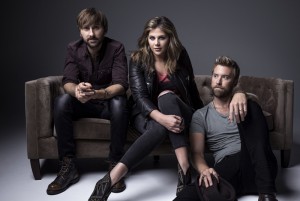(Credit: Joseph Llanes)
Songwriting Session is a new weekly column that goes behind-the-scenes with artists and songwriters. Each Sunday, a new songwriter will share their journey and provide lessons they’ve learned along the way. This week, Lady Antebellum share what they have learned as songwriters.
As you may have already guessed, I am fascinated by the craft of songwriting. So, when I sat down with Lady Antebellum last October to discuss their latest album 747, I asked them to share some tips for aspiring songwriters. They gave some helpful advice which you can read below and watch a clip of as well. If you’re looking for more suggestions on how to write a song, read the Top 10 tips I’ve compiled from country songwriters on Radio.com.
“There’s no right or wrong way to write a song,” Lady Antebellum‘s Charles Kelley advises. “We’ve written many different ways. We usually start with the melody first and then it always evokes some kind of feeling, whether it’s a somber melody or a fun, exciting one. It always finds its way. Some people come in with lyric ideas or even a poem.”
He stresses that the key to being a great songwriter is to “write and write and write.”
“The more you write, the better you get,” he adds. “You’re going to write 100 bad songs before you write one good one and that is the truth.”
Bandmate Hillary Scott couldn’t agree more.
“The more consistently you do it, the better you get. You can always grow and improve,” she says.
Charles says as with anything, there are little tricks to songwriting the more frequently you do it. Like writing a novel or essay, there is an intro, body and conclusion to a song.
“Your bridge is something that needs to sum up and reinforce the tag of the song,” he explains. “If the tag of the song is need you now — well then you get this bridge, what are you trying to say there that when the listener hears it’s one of the last thoughts? It’s ‘I guess I’d raher hurt than feel nothing at all.’ That’s why they’re feeling all of this.”
Hillary adds that the bridge is the writer’s “bring it on home moment.”
“It’s the all-encompassing one or two lines that really describe the rest of the song, the rest of the lyric,” she says.
So what does a songwriting session with Lady Antebellum sound like?
“We love great melodies and a lot of times we start there, whether it’s an idea that’s born on a piano or guitar or some other instrument,” Dave Haywood says. “If you were to walk in on the beginning of a writing session with us, there’d be a lot of humming. Everyone’s humming these big melodies trying to find something we love and gravitate towards. And then for us, a lot of times we jump in, ‘What about this story? What are you going through? What can we write about today?'”
Meanwhile, Hillary stresses the importance of being aware of what’s around you as a writer.
“You have to keep your heart open and your ears and eyes open. The best songwriters are those that allow themselves to be vulnerable,” she confesses. “When people really feel what you’re singing about is when you allow yourself to be vulnerable going into the room. Don’t be afraid because we all feel alike. We all feel the same emotions. The listener knows when you’re being authentic.”
